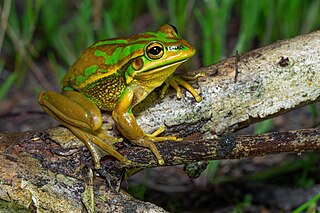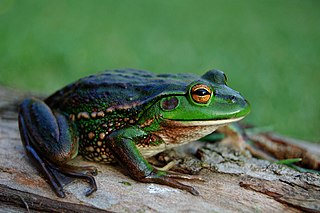
Litoria is a genus of hylid tree frogs, sometimes collectively referred to as Australasian treefrogs.

The green and golden bell frog, also named the green bell frog, green and golden swamp frog and green frog, is a species of ground-dwelling tree frog native to eastern Australia. Despite its classification and climbing abilities, it does not live in trees and spends almost all of its time close to ground level. It can reach up to 11 cm (4.5 in) in length, making it one of Australia's largest frogs.

Ranoidea chloris, commonly known as the red-eyed tree frog or orange-eyed tree frog, is a species of tree frog native to eastern Australia; ranging from south of Sydney to Proserpine in mid-northern Queensland.

The magnificent tree frog, also known as the splendid tree frog, is a species of tree frog first described in 1977. It has a limited range, only occurring on the north-western coast of Australia in the Northern Territory and Western Australia. It has a similar appearance to, and can be confused with, the closely related White's tree frog.

Tyler's tree frog or the southern laughing tree frog is an arboreal species of tree frog. It is native to eastern Australia where it occurs from south-eastern Queensland to the southern coast of New South Wales. It is generally a coastal species and is not found inland.

Rheobatrachus, whose members are known as the gastric-brooding frogs or platypus frogs, is a genus of extinct ground-dwelling frogs native to Queensland in eastern Australia. The genus consisted of only two species, both of which became extinct in the mid-1980s. The genus is unique because it contains the only two known frog species that incubated the prejuvenile stages of their offspring in the stomach of the mother.

The growling grass frog, also commonly known as the southern bell frog, warty swamp frog and erroneously as the green frog, is a species of ground-dwelling tree frog native to southeastern Australia, ranging from southern South Australia along the Murray River though Victoria to New South Wales, with populations through Tasmania. This species' common names vary between states; the name southern bell frog applies to New South Wales, growling grass frog in Victoria and South Australia, and green and gold frog in Tasmania. This species has been introduced to New Zealand.

The Jervis Bay tree frog, also known as the curry frog in reference to its odour, is a species of Australian frog associated with wallum swampland along the east coast of New South Wales; ranging from the Queensland border to eastern Victoria.

The whistling tree frog (Litoria verreauxii), or Verreaux's tree frog, is a species of frog found in Australia. It has been divided into two subspecies, the nominate Verreaux's tree frog and the Verreaux's alpine tree frog. The alpine tree frog is restricted to the southern alps of New South Wales and Victoria. Verreaux's tree frog is widespread throughout south-eastern Queensland, coastal and highland regions of New South Wales, and south-eastern Victoria.

The southern brown tree frog, also known as the brown tree frog, whistling tree frog, or Ewing's tree frog, is a species of tree frog native to Australia: most of southern Victoria, eastern South Australia, southern New South Wales from about Ulladulla—although this species is reported to occur further north—and throughout Tasmania including the Bass Strait Islands, in which state it is the most frequently encountered frog. It has been introduced to New Zealand, where it can be locally abundant.

Littlejohn's tree frog, also called a heath frog or orange-bellied tree frog, is a species of tree frog native to eastern Australia from Wyong, New South Wales, to Buchan, Victoria.

The Booroolong frog is a species of stream-dwelling frog native to the Great Dividing Range in New South Wales, Australia. It is a member of the Hylidae, or the "tree frog" family. The Booroolong frog is classified by the IUCN as a Critically Endangered Species.

The desert tree frog, or little red tree frog, is a species of tree frog native to Australia, southern New Guinea, and Timor. It is one of Australia's most widely distributed frogs, inhabiting northern Australia, including desert regions and much of temperate eastern Australia. It is one of the few Australian tree frogs to inhabit arid, tropical, and temperate climates.
Anstisia vitellina, commonly known as the orange-bellied frog, is a species of frog in the family Myobatrachidae. It is endemic to a 20 hectare area near Margaret River in Southwest Australia. It is vulnerable to extinction due to fire and the destruction of habitat caused by feral pigs.
Beck's tree frog is a species of frog in the subfamily Pelodryadinae. It is endemic to Papua New Guinea. Its natural habitats are tropical moist montane forests, grasslands and streams. It was first described by the British biologist and herpetologist Arthur Loveridge in 1945 and is named in honour of the American ornithologist and explorer Rollo Beck who led the Whitney South Seas Expedition in the 1920s, collecting bird and other specimens from thousands of islands in the South Pacific.

Davies' tree frog is a species of frog in the subfamily Pelodryadinae. It is endemic to Australia. Its natural habitats are subtropical or tropical dry forests, subtropical or tropical moist lowland forests, subtropical or tropical dry shrubland, and rivers. It is currently threatened by habitat loss.

Spencer's river tree frog, also known as Spencer's tree frog or spotted tree frog, is a species of frog in the subfamily Pelodryadinae.

The New England tree frog or glandular tree frog is a species of frog in the subfamily Pelodryadinae, endemic to Australia. Its natural habitats are temperate forests, subtropical or tropical moist lowland forests, subtropical or tropical moist montane forests, temperate shrubland, rivers, and pastureland. It is threatened by habitat loss.

Leptopelis macrotis, sometimes called the big-eyed forest tree frog, is a species of frog in the family Arthroleptidae. It is found in the rainforests of Sierra Leone, southern Guinea, Liberia, Ivory Coast, and southern Ghana. Notice that similar common name "big-eyed tree frog" is sometimes used for Leptopelis vermiculatus from Tanzania and for Litoria exophthalmia from New Guinea.
The Kroombit tree frog, or Kroombit treefrog, is a species of small frog that is endemic to Australia.
















